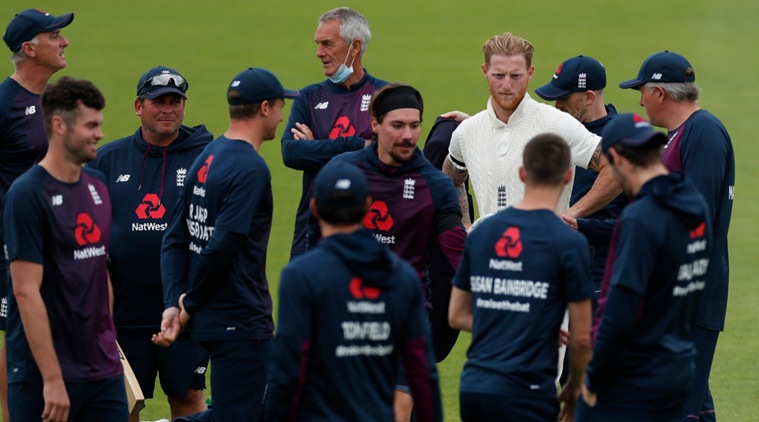 Ben Stokes is captaining England for the first time in the 1st Test vs West Indies. (Twitter/EnglandCricket)
Ben Stokes is captaining England for the first time in the 1st Test vs West Indies. (Twitter/EnglandCricket)
England have resumed international cricket with a blistering pace attack in the 1st Test vs West Indies, but statistics show their recourse to extra speed has been ill-suited to conditions in Southampton. Had Ben Stokes, in going for his Durham teammate Mark Wood over the slower but perhaps more probing Stuart Broad or Chris Woakes, already made his first strategic blunder before the first ball of the match?
Mark Wood’s average speed in this Test has been 144.64 kph, or 89.88 mph, the fastest innings performance by an English bowler in a home Test since such data has been recorded from 2006. He bowled a ball at 152.7 kph on Day 3,the fastest ball of his Test career.
Follow LIVE | England vs West Indies 1st Test Day 4
Wood’s returns in the first innings were meagre though. His only wicket in a spell of 1-74 was West Indies No. 11 Shannon Gabriel. Jofra Archer, the other ace of pace in the England attack, went wicketless.
Anderson, who bowls at just above 80 mph, was the one who bowled the most overs. He delivered 11 maidens in his 25 overs. England’s three other seamers delivered 10 between them.
This is mainly the effectiveness of Jason Holder, but pace has struggled in this match – as this @CricViz graphic shows. #ENGvWI pic.twitter.com/hBZ69UkSdj
— The CricViz Analyst (@cricvizanalyst) July 10, 2020
As this Cricviz analysis shows, balls above 88 mph have been the least productive in the Test. Jason Holder and James Anderson, two bowlers whose average speeds are in the lower 80s have been the most successful.
Speaking from the commentary box on Day 3, Nasser Hussain said England has traditionally looked for extra pace from fast bowlers – “Duncan Fletcher (England coach during his time), for instance, only looked for extra pace in a bowler”. They might have found the answers to their prayers in Wood, but the answer seems to have come at an inopportune time.
“Obviously you need control,” James Anderson said after the day’s play on Friday. “We saw West Indies bowl well. They had a couple of bowlers who offered control in Holder and (Kemar) Roach and that gave the quicker guys the freedom to bowl fast. You need a balance.”
Jofra Archer has struggled to find movement in this match so far. Only Ben Stokes – who has been operating with a much older ball – has found less swing than him in the match.
Archer might not be aiming to swing the ball, but typically he finds more movement than Wood. #ENGvWI pic.twitter.com/PEGC870Bbo
— The CricViz Analyst (@cricvizanalyst) July 10, 2020
Generating seam movement has seemed to be the way to go in the 1st Test so far. Jofra Archer and Ben Stokes have been the bowlers who have found the least movement in the match.
As an analysis showed during the day’s play on Friday, West Indies bowlers had extracted 1.7 degrees of swing, while England — even with the king of swing James Anderson in their ranks — were only able to manage 0.8 degrees.
As Hussain mentioned, in English conditions, probing lines at gentle pace has often proved to be more venomous than express pace.